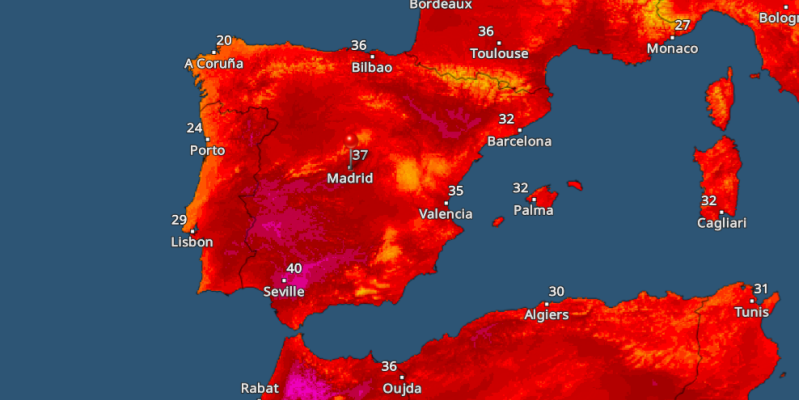
Spain Gripped by Intense Heatwave as Temperatures Soar Towards 43°C
Spain is currently enduring an intense heatwave that has swept across much of the country this week. The national weather agency, AEMET, has issued orange-level alerts in several regions, warning residents and tourists alike of dangerously high temperatures. In the south, particularly in areas such as Córdoba, Seville, and parts of Extremadura, temperatures have already surpassed 40°C, and forecasters warn that some locations could approach or even exceed 43°C in the coming days. This extreme heat is the result of a mass of hot air trapped over the Iberian Peninsula by a high-pressure system, compounded by a weather anomaly in the west known as a DANA (an upper-level isolated depression), which has helped intensify the heat dome effect. Central areas of the country, including Madrid and the Tajo valley, are also experiencing searing conditions, with highs expected between 38°C and 40°C. Along the Mediterranean coast, cities like Valencia and Barcelona also feel the heat, though slightly moderated by coastal breezes, with temperatures hovering between 32°C and 35°C.
Northern Spain, including parts of the Cantabrian coast, is somewhat cooler in comparison, with highs closer to 25°C to 30°C. However, even in these areas, the heat is significantly above seasonal averages. What’s particularly concerning is the occurrence of “tropical nights” in many regions, especially in the south and along the coast. Overnight lows are expected to remain stubbornly high, often above 22°C or 24°C, making it difficult for the body to recover from the daytime heat and disrupting sleep for many. Health authorities are urging the public to take this heatwave seriously. AEMET’s warnings highlight the elevated risk of heat exhaustion and dehydration. Tourists, especially those unfamiliar with Spain’s summer climate, are advised to stay out of the sun during the hottest parts of the day, typically between noon and 6 p.m. The government has also issued reminders to avoid alcohol and caffeinated beverages, as these can worsen dehydration, a risk that becomes more serious with sustained exposure to such extreme heat.
There is also a chance of nighttime electrical storms, hail, or short but intense rain showers in some mountainous and coastal areas, especially as the heat interacts with humid Mediterranean air. These conditions can create unstable weather patterns and are difficult to predict, adding another layer of complexity to the week’s forecast. This episode is part of a wider trend of more frequent and severe heat events across Europe. Climate scientists from organisations like Climate Central have emphasised that these types of heatwaves are becoming significantly more likely due to human-induced climate change. Compared to similar events from previous decades, the current wave is estimated to be up to 5°C to 8°C hotter, and up to five times more likely to occur under present climate conditions. In short, this heatwave is an early and urgent reminder of the growing climate risks facing Europe. With high temperatures continuing through the weekend and tropical nights offering little relief, residents and visitors must stay alert, hydrated, and informed. Spain’s beloved summer sun has taken a dangerous turn, and caution is not just advised, it’s essential.












 Back
Back











